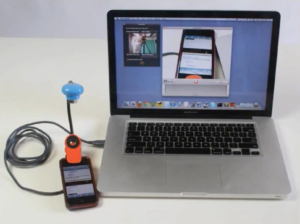 I am working on a project which calls for the following:
I am working on a project which calls for the following:
“… think through the process of setting up and conducting a usability test for mobile devices … you will design the location and test protocols, including any logistical and equipment considerations necessary to conduct a real test.”
I found “A Big Nerd Ranch Tech Talk: Mobile Usability Testing,” by Jenn Downs (watch it below), provides a helpful starting point for someone thinking about setting up a mobile usability test — that’s where I am right now, at least. I am at the beginning stages of figuring out the best ways to set up the test. It’s necessary to know these basic steps, because here’s the scenario I am working through:
The company you work for has a web site that used to meet the needs of most of its users. That was until almost everyone started using phones and tablets to look up products, services, locations and price. The analytics team at your company was surprised to see that in the past year, 15% of the company traffic is from iPads and other tablets, 20% is from iPhones and 30% is from Android devices.
So now nearly two-thirds of the company web traffic is on mobile devices. Everyone just assumed that the current web site would scale properly on mobile devices and that people would be able to get what they needed. Unfortunately, that’s not the case. The customer support center is getting inundated with calls concerning problems finding information while trying to use the desktop site on a mobile browser. It’s time to fix this. The company has decided that it needs to create a responsive design that adjusts to device type and screen resolution, and work on dedicated apps for iOS and Android that display web pages.
But first they want to do some testing on mobile devices to see what areas customers struggle with. There is budget for this project, but no one seems to know how to record mobile device interactions properly. As the UX member of the team it is up to you to create a mobile usability setup in the current usability lab. Your job is to create a setup that will provide great results.”
As a web producer for a news content website, I know all too well about the shift to mobile. Companies, including media companies, continue to struggle with this shift. Right now, if your site is not responsive, forget it. You’re either mobile friendly or you’re dead. So, this is an extremely important task for the company and it deserves top-notch UX research from the beginning.
As stated: I am now working to design/create/plan a mobile usability test setup that will provide great results for this company.
I will keep you posted. Here’s that video: